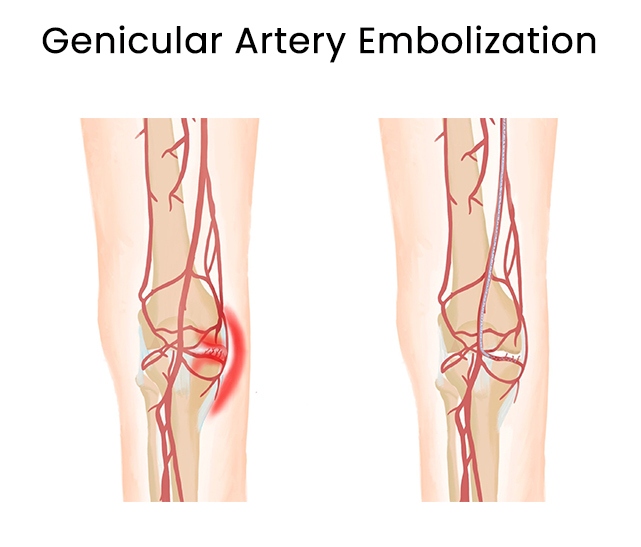Quick Links
- A State-of-the-Art Treatment for Knee Pain
- Understanding Knee Pain
- Causes and Risk Factors of Osteoarthritis
- Real Patient Testimonial
- Symptoms of Osteoarthritis
- The Genicular Artery Embolization Procedure
- Genicular Artery Embolization Aftercare
- Benefits Over Other Knee Pain Relief Options
- Frequently Asked Questions
- Schedule a Consultation
A State-of-the-Art Treatment for Knee Pain
GAE represents the latest advancement in interventional radiology—a highly targeted approach that blocks the tiny arteries fueling inflammation in the knee joint. Unlike joint replacement surgery or other aggressive procedures, GAE requires no hospital stay, no stitches, and minimal downtime. At South Florida Vascular Associates, our board-certified interventional radiologists perform this advanced treatment in a calm, comfortable outpatient setting.

Understanding Knee Pain
Osteoarthritis is the most common cause of chronic knee pain, especially in adults over 50. This degenerative joint disease breaks down the cartilage that cushions the knee, leading to pain, swelling, stiffness, and reduced mobility. Over time, the inflammation increases as the body sends more blood to the affected area through the genicular arteries, but GAE works by reducing this abnormal blood flow to target the problem at its source.
Book Your GAE Appointment
Contact us today to schedule your appointment.
BOOK APPOINTMENTCauses and Risk Factors of Osteoarthritis
Osteoarthritis (OA) develops gradually over time and is influenced by a combination of mechanical, biological, and lifestyle factors. While wear and tear of the joint cartilage is a key contributor, several other elements can increase your risk of developing osteoarthritis related knee pain. These include:
- Age: The risk of osteoarthritis increases significantly in individuals over the age of 50, as cartilage naturally breaks down with age.
- Joint Injury or Trauma: Previous injuries to the knee, whether from sports, accidents, or surgery, can accelerate cartilage degeneration.
- Repetitive Stress: Occupations that place repeated stress on the knees, such as heavy lifting, kneeling, or high-impact sports, contribute to joint damage over time.
- Obesity: Excess body weight places additional strain on weight-bearing joints, particularly the knees.
- Family History: Those with a family history of osteoarthritis may be more prone to developing the condition themselves.
- Sedentary Lifestyle: Lack of physical activity can weaken the muscles that support the joints, reducing joint stability and accelerating cartilage breakdown.
Symptoms of Osteoarthritis
Osteoarthritis (OA) of the knee occurs when the protective cartilage within the joint gradually wears down, leading to inflammation, reduced mobility, and pain. As the condition progresses, the bones may begin to rub against each other, further increasing discomfort and joint damage. You may be a candidate for Genicular Artery Embolization (GAE) if knee osteoarthritis is causing persistent and disruptive symptoms such as:
- Ongoing or worsening knee pain
- Stiffness or swelling, particularly after rest or in the morning
- Difficulty walking, bending, or climbing stairs
- A grinding or crunching sensation within the joint
- Pain that intensifies following physical activity
- Reduced range of motion in the knee
The Genicular Artery Embolization Procedure
GAE is performed in the office under local anesthesia with light sedation, making it a comfortable and low-risk experience for most patients. During the procedure, a small catheter is inserted through a tiny puncture in either the groin or foot. Using advanced imaging technology, the physician carefully guides the catheter to the genicular arteries that supply blood to the inflamed areas of the knee. Once in position, tiny particles are injected to block these abnormal blood vessels, effectively reducing blood flow to the inflamed tissue. This process helps to alleviate pain and improve joint function over time. The entire procedure typically takes just 60 to 90 minutes, and patients return home the same day.
Genicular Artery Embolization Aftercare
After the procedure, patients resume their normal activities within just a few days. Some mild discomfort or bruising may occur at the catheter insertion site, but this typically resolves within a few weeks.

Receive Expert Care No Matter Where You Are
Traveling to South Florida for vascular treatments like Prostate Artery Embolization, Uterine Fibroid Embolization, Hemorrhoidal Artery Embolization, and Genicular Artery Embolization allows you to access expert care from our renowned vascular specialists, regardless of your location. We offer same-day consultations, and most procedures can be scheduled within a week—making it easier than ever to receive timely, effective care. Our team is dedicated to helping you plan a seamless and comfortable visit to our state-of-the-art facilities in South Florida, ensuring that your medical journey is complemented by a relaxing stay. Whether you’re seeking relief from BPH symptoms or fibroid-related discomfort, we invite you to explore our travel resources to make your visit to South Florida both therapeutic and enjoyable.
LEARN MOREBenefits Over Other Knee Pain Relief Options
Genicular Artery Embolization (GAE) is a highly effective, minimally invasive solution for managing severe knee pain caused by osteoarthritis. Unlike traditional surgical options, GAE requires only a tiny catheter insertion and is performed under local anesthesia with light sedation. There are no large incisions, no general anesthesia, and no prolonged hospital stays, making it an ideal option for patients seeking a faster, safer path to relief. GAE is often a more appealing choice compared to more invasive procedures such as:
- Knee Replacement Surgery
- Knee Arthroscopy
- Radiofrequency Ablation
- Intra-articular Steroid Injections
- Hyaluronic Acid Knee Injections
Many surgical treatments involve significant recovery time, higher complication risks, and the potential for permanent joint changes. In contrast, GAE preserves the natural knee structure and offers a quicker return to normal activity. It’s a safe, outpatient alternative that can significantly improve quality of life without compromising joint integrity.
Frequently Asked Questions
Is GAE painful?
Is there any downtime after GAE?
Are there any risks with GAE?
What is the most common cause of knee pain?
Is GAE an outpatient procedure?
When can I get back to working out after GAE?
Schedule a Consultation
Don’t let debilitating knee pain limit your lifestyle. Whether you’ve tried everything or are just beginning your search for answers, Genicular Artery Embolization may be the solution you need. Contact South Florida Vascular Associates today to schedule your consultation and take the first step toward lasting pain relief.







